Search Thermo Fisher Scientific
Invitrogen
Desmin Monoclonal Antibody (DE-U-10), eFluor™ 660, eBioscience™
This Antibody was verified by Relative expression to ensure that the antibody binds to the antigen stated.
FIGURE: 1 / 17
Desmin Antibody (50-9747-82) in IHC (P)
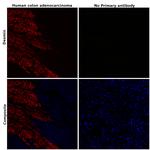
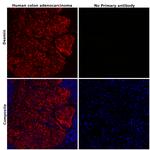
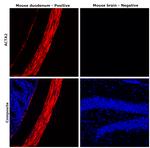
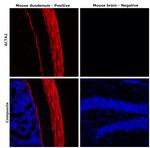
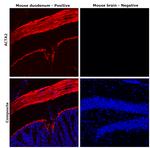
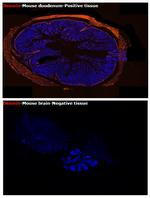
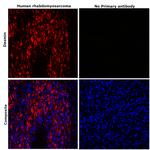
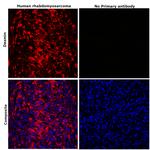

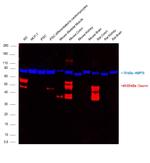


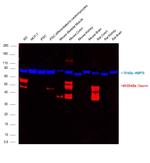
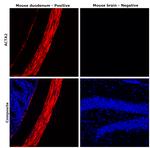
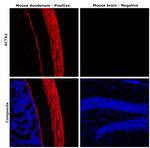

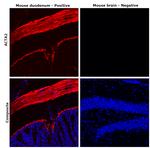
Product Details
50-9747-82
Species Reactivity
Published species
Host/Isotype
Recommended Isotype Control
Class
Type
Clone
Conjugate
Excitation/Emission Max
Form
Concentration
Purification
Storage buffer
Contains
Storage conditions
Shipping conditions
RRID
Product Specific Information
Description: The monoclonal antibody DE-U-10 recognizes desmin. Desmin is the protein subunit of class-III intermediate filaments. Desmin is found predominantly in skeletal, cardiac, and smooth muscle. Desmin plays a role in muscle cell development and differentiation, muscle cell architecture and structure, and mitochondrial function. Desmin forms scaffolds around the Z-disk of sarcomeres in muscle cells. Desmin knockout mice exhibit defects in skeletal, smooth, and cardiac muscle and have impaired mitochondrial function. Mutations in Desmin result in conditions such as desmin-related myopathy (DRM), cardiomyopathy dilated type 1I (CMD1I), and neurogenic scapuloperoneal syndrome Kaeser type (Kaeser syndrome).
The DE-U-10 antibody recognizes human, mouse, rat, feline, bovine, goat, hamster, sheep, porcine, rabbit, and chicken desmin. The DE-U-10 antibody will also label tumors derived from muscle tissue, such as leiomyomas and rhabdomyosarcomas.
Applications Reported: This DE-U-10 antibody has been reported for use in immunohistochemical staining of formalin-fixed paraffin embedded tissue sections, microscopy, and immunocytochemistry.
Applications Tested: This DE-U-10 antibody has been tested by immunohistochemistry of formalin-fixed paraffin embedded human tissue using high pH antigen retrieval and can be used at less than or equal to 10 µg/mL. This DE-U-10 antibody has been tested by immunocytochemistry of fixed and permeabilized cells and can be used at less than or equal to 10 µg/mL. It is recommended that the antibody be carefully titrated for optimal performance in the assay of interest.
eFluor® 660 is a replacement for Alexa Fluor® 647. eFluor® 660 emits at 659 nm and is excited with the red laser (633 nm). Please make sure that your instrument is capable of detecting this fluorochome.
Excitation: 633-647 nm; Emission: 668 nm; Laser: Red Laser.
Filtration: 0.2 µm post-manufacturing filtered.
Target Information
Desmin (approximately 53 kDa) exhibits a high degree of tissue specificity, its expression being predominantly confined to all types of muscle cells (cardiac, skeletal and smooth muscle). Regulation of desmin expression is stage and tissue-specific, since it is induced during terminal development of, for example, skeletal muscle cell differentiation. In skeletal en cardiac muscle cells desmin is localized in the Z-disk region and at the intercalated disk. The expression pattern of desmin in smooth muscle is much more heterogenous. Coexpression of vimentin and desmin has been observed in tumors derived from muscle tissue, i.e. rhabdomyosarcomas and leiomyosarcomas. Furthermore, during myocard dysfunction dramatic changes in the distribution of desmin have been observed.
For Research Use Only. Not for use in diagnostic procedures. Not for resale without express authorization.
Bioinformatics
Protein Aliases: CMD1I; Desmin; desmin-like protein; FLJ12025; FLJ39719; FLJ41013; FLJ41793; intermediate filament protein; MFM1; muscle-specific intermediate filament desmin; muscle-specific intermediate filament protein; mutant desmin p.K241E; SCPNK
Gene Aliases: CSM1; CSM2; DES; I79_018932; LGMD2R
UniProt ID: (Bovine) O62654, (Pig) P02540, (Human) P17661, (Rat) P48675, (Mouse) P31001

Performance Guarantee
If an Invitrogen™ antibody doesn't perform as described on our website or datasheet,we'll replace the product at no cost to you, or provide you with a credit for a future purchase.*
Learn more
We're here to help
Get expert recommendations for common problems or connect directly with an on staff expert for technical assistance related to applications, equipment and general product use.
Contact tech support

